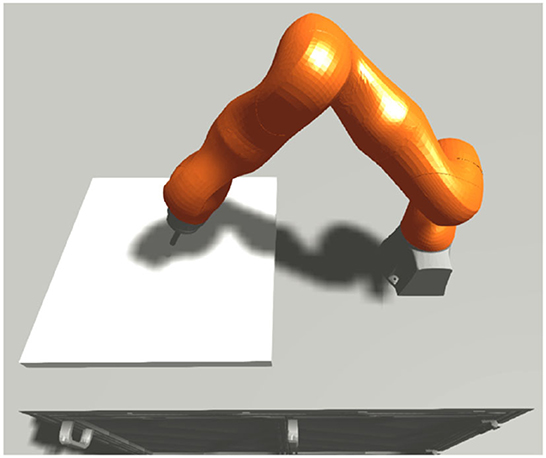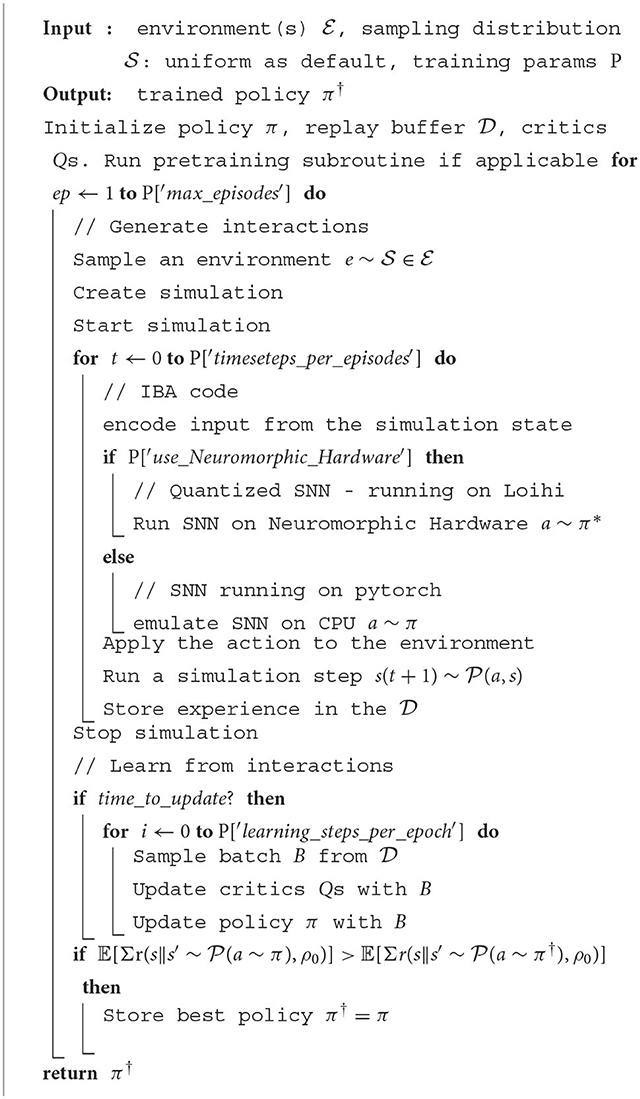- Department of Neuromorphic Computing, Fortiss-Research Institute, Munich, Bavaria, Germany
Neuromorphic hardware paired with brain-inspired learning strategies have enormous potential for robot control. Explicitly, these advantages include low energy consumption, low latency, and adaptability. Therefore, developing and improving learning strategies, algorithms, and neuromorphic hardware integration in simulation is a key to moving the state-of-the-art forward. In this study, we used the neurorobotics platform (NRP) simulation framework to implement spiking reinforcement learning control for a robotic arm. We implemented a force-torque feedback-based classic object insertion task (“peg-in-hole”) and controlled the robot for the first time with neuromorphic hardware in the loop. We therefore provide a solution for training the system in uncertain environmental domains by using randomized simulation parameters. This leads to policies that are robust to real-world parameter variations in the target domain, filling the sim-to-real gap.To the best of our knowledge, it is the first neuromorphic implementation of the peg-in-hole task in simulation with the neuromorphic Loihi chip in the loop, and with scripted accelerated interactive training in the Neurorobotics Platform, including randomized domains.
1. Introduction
Neuromorphic hardware is characterized by high energy efficiency, low latency, and adaptability. These characteristics are of critical importance in robot control tasks, where real-time decision-making is a key factor, where energy is a constraint, and where environments are dynamic.
This hardware can efficiently run brain-inspired models known as spiking neural networks (SNN) (Hodgkin and Huxley, 1952; Arthur and Boahen, 2011). However, optimally training these networks remains an open question, partly on account of a lack of understanding for how the human brain learns (Lillicrap et al., 2020).
Different approaches have been proposed in the last years to cope with this challenge. Studies such as Bellec et al. (2020) and Yang et al. (2023) have investigated biologically plausible learning approaches. The same authors provide new perspectives for efficiently learning in SNNs by using (a) the minimum error entropy criterion (Yang et al., 2022) and (b) the information theoretic learning approach (Yang and Chen, 2023). In any case, how the brain manages to efficiently learn with its local constraints remains a conundrum.
Furthermore, training neural networks becomes specially challenging in the case of non-static or interactive learning, wherein the dataset distribution depends on the model being optimized itself. This is true of complex robot control tasks, where reinforcement learning (RL) is an usual approach for model fitting. When those models are SNNs, the formalism is known as spiking reinforcement learning. Recent such as Tang et al. (2020, 2021) have investigated this formalism for learning in environments with continuous state and action spaces, as usually seen in robotics.
Robot learning can be complicated by the additional challenges of limited hardware resources, time and cost constraints, both leading to too few learning data. Therefore, simulators are a key element for collecting non-static data. However, simulations may not model reality with sufficient accuracy, and the learnt behaviors may not generalize to the real domain. With additional effort though, this problem, known as the sim2real gap, can be dealt with. System identification, domain adaptation, and domain randomization are techniques that have been proposed in literature (Inoue et al., 2017; Weng, 2019; Beltran-Hernandez et al., 2020; Kaspar et al., 2020) to reduce this gap.
To approach these issues, a number of integration frameworks have been developed. The most relevant may be the neurorobotics platform (NRP), developed as part of the Human Brain Project. The NRP is an open source integration framework for robot and SNN simulators, intended for in-silico neurorobotic experimentation (Falotico et al., 2017). Herein, we extend its functionalities to integrate neuromorphic hardware (Loihi) in the loop to use gradient information from multiple simulations in learning algorithms and to randomize environments to learn in situations characterized by domain uncertainty or variability. Using the Loihi chip in the simulation loop of the NRP has been previously implemented (without learning) by Angelidis et al. (2021); however, this was using the Nengo framework which adds considerable overhead and architectural constraints. In this study, the network architecture is customizable, the synapric weights are learned, and we use a direct integration with Loihi's low-level SDK NxSDK over multiple simulation episodes.
In this study, as a proof of concept, we also solve a model-free robotic force-guided object insertion task. Object insertion has most of the elements of a traditional robotic task, and therewith, our approach can be easily generalized to a wide array of robotic use cases. The programming of robot systems to handle object insertion tasks in modern manufacturing scenarios (e.g., plugging in connectors in electronic devices for the automotive industry or clipping elements in industrial assemblies) is challenging due to complex contact dynamics and friction.
There are still many knowledge gaps around spiking RL for robotics. Integrating neuromorphic hardware with robot simulation environments and reinforcement learning algorithms is a key step to facilitate research in this emerging and promising field of study. Doing this can contribute in the near future to solve challenging real robotic tasks in innumerate robotic fields from industrial to assistive robotics.
2. Materials and methods
In Subsections 2.1 and 2.2, we describe the simulation and integration environment as well as the neuromorphic hardware. Then, the methods are described, including the spiking neural networks used, the reinforcement learning algorithm, the robot control and simulation setup, as well as the connectivity between these and the setup for training neurorobots in domains with parametric uncertainty.
2.1. Simulation tools and frameworks
The neurorobotics platform v3 (NRP)1 is used in this study as an integration environment for running simulations and defining learning schemes. The NRP has been developed as a major deliverable of the Human Brain Project (Falotico et al., 2017). It allows to connect customized SNNs (brain models) to robot environments. Additionally, experiments can be performed on a cluster of high-performance computers. These simulations can be run on a local or remote machine; in both cases, users can create experiments, simulate them, visualize them, and interact with them through an intuitive graphical users interface.
The NRP consists of six main components:
• the brain simulator, which runs a spiking neural network over different possible backends, including hardware,
• the world simulator (based on Gazebo2),
• the brain interface and body integrator (BIBI) for building a communication channel between the former two,
• the closed loop engine (CLE) for orchestrating them,
• a backend exposing a web server with a RESTful API,
• a frontend to provide a graphical interface.
Figure 1 shows the frontend view and some of its functionalities, while Figure 2 shows how all the NRP elements are timely orchestrated by the CLE. The NRP adds two optional components for more flexible and advanced integration with external software:
• the Integrated Behavioral Architecture (IBA) to execute external code within the simulation loop
• the Virtual Coach (VC): a python interface to the NRP that enables to script simulations
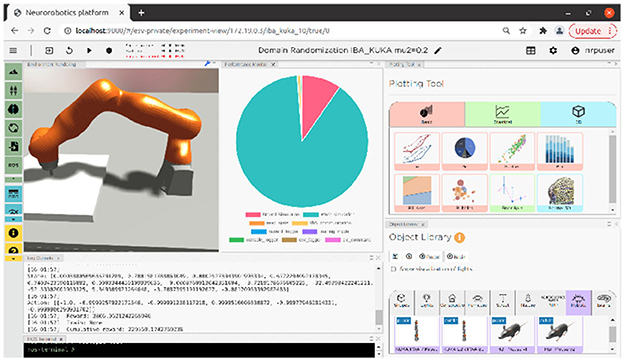
Figure 1. NRP v3 frontend view including environment rendering, performance monitoring, plotting tool, log console, object library, and ROS terminal.
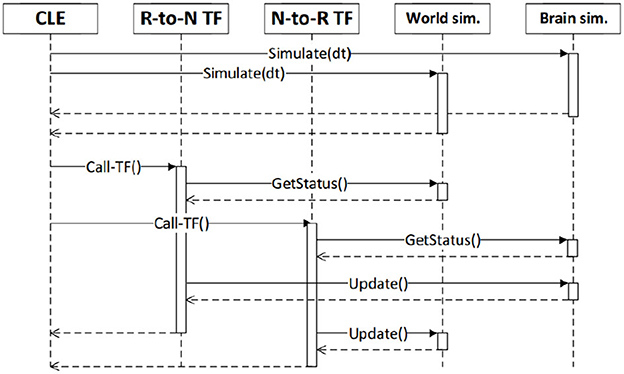
Figure 2. Synchronization between the components of a simulation and user code (robot-to-neuron functions, referred as “R-to-N TF” and neuron-to-robot functions), as orchestrated by the CLE. Reproduced from Falotico et al. (2017).
These two extensions of the NRP will be described later.
2.1.1. Brain simulation: the model
The NRP supports executing brain code from a set of frameworks including Nest, PyNN, and Nengo. These supported frameworks are run in the simulation loop and can exchange information with the other components at every execution step. For this study, the SNNs used were defined in PyTorch and NxSDK.3 Since these frameworks are supported, we made use of the IBA mechanism to run them as the external code in the NRP.
2.1.2. IBA: embedding external code
The integrated behavioral architecture (IBA) is a mechanism for the execution of external code, including AI frameworks such as PyTorch. With it, unsupported libraries can be embedded in the NRP. For example, it can run Tensorflow code synchronized with the world simulation. The IBA is implemented as a ROS launch file that loads GazeboRosPackages modules. These modules are called by the Closed-Loop Engine (CLE) within each loop iteration of a simulation. We used this mechanism to embed our reinforcement learning algorithm, in both versions, PyTorch on CPU and NxSDK on Loihi 1.
2.1.3. World simulation: the environment
The environment is defined as a Gazebo model simulated in the NRP-backend. Interactions between the world simulation and the brain can be defined via “transfer functions” in the NRP or, in our case, via ROS communication over topics for the IBA brain code. The world environment modeled for this manuscript is described in detail in Section 2.3.
2.1.4. Virtual coach: scripted interactions between simulations
The Virtual Coach is a tool for scripting front-end interactions in the NRP, which allows for defining and running simulations automatically, as well as interacting with them. This python API enables to edit experiments, clone them, launch and control simulation runs, and retrieve data. In this study, we use those capabilities to script closed-learning loops within the NRP.
2.2. Neuromorphic hardware
The neuromorphic processor used for running the SNNs in this study is the first generation Loihi research chip (Davies et al., 2018). Loihi is a digital discrete-time neuromorphic chip with a specialized scalable architecture optimized to run and train programmable SNNs. Each Loihi chip contains over 131 thousand neurons partitioned over 128 cores connected in a mesh; every core contains 1,024 neurons, with the cores responsible for allocating synaptic states (128 kB) and managing routing tables (20 kB). The neurons are current-based-synapse leaky-integrate-and-fire neurons (CUBA-LIF). The weights are stored in the neuromorphic core in a compressed format to enable efficient allocation. Additionally, the synapse weights can have variable precision (from one to nine bits).
Neurons communicate to each other between cores based on the routing tables and via spikes, which are 32 bit messages that contain destination addresses, source addresses, and payloads. Both the mesh and the cores are built with asynchronous circuits and communicate event-driven data; even though Loihi has no clock, periodic wave fronts are used for inter-core spike synchronization. Each Loihi chip also has three microcontroller-class x86 processors which can be used for different proposes such as data format conversion and bridging encodings.
More specifically, the neuromorphic hardware used in this study was a Kapoho Bay device with two Loihi chips. It has 256 neuromorphic cores with 262,144 neurons, and 260,000,000 synapses.
2.3. The experiment—robotic force-torque-based object insertion
The robotic peg-in-hole task has been established as a benchmark for interactive control strategies in academic and industrial research. This task consists of two phases: search and insertion. The search phase consists in finding the hole position and reaching an initial pose4 with the manipulator. The insertion phase involves not only motion but also force interaction with the environment and can be approached through either model-based or model-free strategies. In the case of contact model-based strategies, a contact model analysis decomposes the peg-in-hole task into contact-state recognition and compliant control. On the other hand, contact model-free strategies treat both components as a whole (Xu et al., 2019). In this study, we approach the searching phase from a model-free perspective.
2.3.1. World setup
The world setup for the peg-in-hole task is depicted in Figure 3. We used a round peg with a flat end and a round hole with a 0.5 mm clearance depicted in Figure 4. The platform with the hole is attached to a horizontal plane inside the dexterous space of the robot, and the peg is connected to a force-torque sensor attached to the robot as an end-effector. Both the robot and the insertion platform are located on a cabinet with the robot controller.
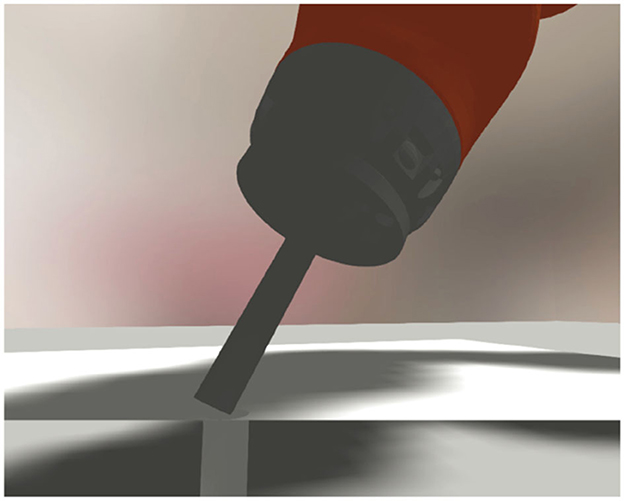
Figure 4. Zoomed-in picture of a sectional cut of the insertion-hole, the peg, the force-torque sensor, and the last joint of the robot.
2.3.2. Robot and control
The robot used in simulation is a Kuka LBR iiwa 7 R800, a redundant lightweight manipulator equipped with torque sensors at each of its seven joints. A simulated Cartesian Impedance Controller (CIC) was implemented to soften contact interactions in the task space. The CIC controller leads the closed-loop response of the system to simulate the desired spring-damper dynamics in the Cartesian coordinates with respect to the target position and velocities. The control law is given by Equation 1, which can be simplified by setting the desired apparent inertia matrix to match the real Cartesian inertia matrix as in Equation 3.
where τ is the torque command for the robot, M is the robot inertia matrix, Mm the desired apparent inertia matrix, Mx the real Cartesian inertia matrix, C the Coriolis matrix, Ja denotes the robot analytic Jacobian, Dm the desired damping, Km is the desired stiffness, q is the joint positions, x is the current Cartesian pose, xd is the desired Cartesian pose, and the dot notation denotes the first and second time derivatives.
The Cartesian impedance framework is introduced in Hogan (1985). Albu-Schaffer and Hirzinger (2002) provides an extension of the CIC to lightweight robots with flexible links such as the Kuka iiwa LBR, while Albu-Schaffer et al. (2003) provides an extension of the CIC to redundant manipulators with null space considerations. Additionally, the latter presents two different strategies for tuning the CIC. The second tuning scheme presented therein has been used to tune the controller in this study.
2.3.3. Sim-to-real gap
Simulation models can significantly differ in their behavior with respect to their corresponding real systems. Models of reality used for simulations can diverge from real data. Some of the most critical variables leading to these differences in the field of robotics include object position, dimensions and masses, robot link masses and inertia, surface friction coefficients, controller gains, and damping factors (Weng, 2019). Alternatively, disturbances and sensor noise represent a further source of discrepancies between modeled and real environments.
2.4. Implementation of the learning scheme
In order to teach the arm to insert the peg, we make use of RL. We first outlined the Markov decision process (MDP) formalization as well as the associated reward function. The chosen RL approach is then described. With these, we then used the Virtual Coach (Section 2.1.4), together with the IBA (Section 2.1.2), to define complex learning environments requiring software and hardware not supported natively in the NRP.
2.4.1. Utilized Markov decision process
The MDP can be defined as a tuple in the form , where is the state space, is the action space, is the reward function, is the transition probability function, and ρ0 is the initial state distribution.
For the insertion task, the state space is a 13-dimensional set of continuous variables including the robot's current coordinates, alongside the measured forces and torques. The action space is a 6-dimensional set of continuous variables, namely, the target values for the Cartesian impedance controller described in the former sections. The reward function is defined as
Here fd, τd, and zd are the desired force, torque, and depth. Similarly f, τ, and z are the measured values for these three quantities. The weights w allow us to adjust the importance we assign to each of these terms. Recall that the goal is to learn insertion based on the force-torque profile measured by a sensor attached to the end-effector (the peg). This is the motivation behind the first two terms. The third term serves to quickly teach the arm to remain on the table. Without this term, the number of training episodes becomes impractically large.
The transition probability function is given by the world dynamics of the randomized domain set, and the initial state distribution ρ0 is defined by a normal distribution centered on the approach pose.
2.4.2. Reinforcement learning implementation
We now describe the implementation and the detailed learning setup. The reinforcement learning cycle is composed of the agent interacting with the environment. The latter has been described in Section 2.3.1 and is simulated in Gazebo within the NRP. The simulator takes an action a, and after one step, it generates the next state s. Meanwhile, a policy dictates the actions a for the agent based on s to maximize a reward. The policy is implemented with the IBA to run spiking neural networks in classical and neuromorphic hardware both in inference and in training modes. For this, we activated a special virtual environment in the IBA start process and run the models (with NxSDK for On-Chip spiking actor network, and pytorch, scikitlearn for the other networks) at every simulation/CLE step.
This reinforcement learning loop repeats until it completes an episode, then the virtual coach script handles the beginning and end of multiple simulations, gathers the data to feed them to the reinforcement learning algorithm, and updates the models accordingly, as sketched in Figure 5. This includes updating the policy and the value function. The specific update rules, models, and further details are described in the following sections.
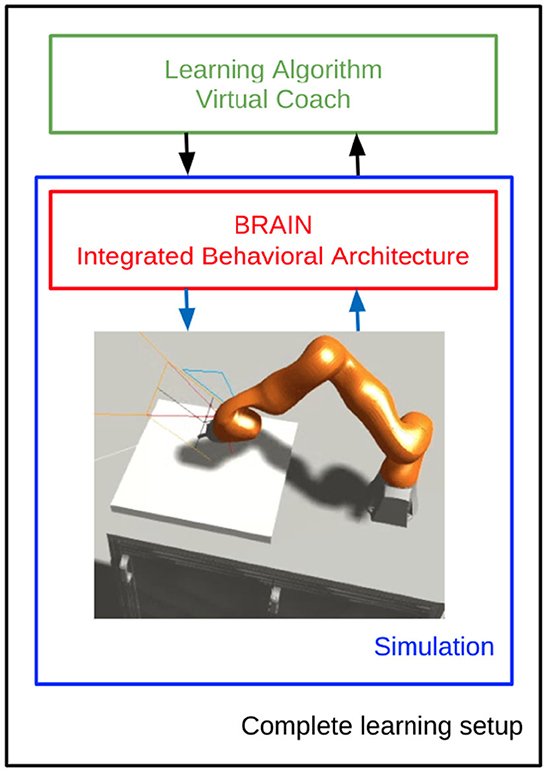
Figure 5. Learning architecture scheme in the NRP. Refer to the pseudo-code in Algorithm 1 and to the schema in Figure 8 for a more detailed description.
2.4.3. Soft actor critic
In this study, the reinforcement learning algorithm used is a version of soft actor critic (SAC) (Haarnoja et al., 2018), which optimizes a stochastic policy in an off-policy fashion. The policy is trained to maximize a trade-off between expected return and entropy. The intuition behind entropy-regularized RL is succeeding at the task while acting as randomly as possible. This contributes to preventing the policy from prematurely converging to an undesired local optimum.
SAC achieves state-of-the-art performance that surpasses previous on-policy and off-policy methods in sample efficiency and asymptotic performance. Moreover, SAC is more stable and shows more robustness to different random seeds than other off-policy algorithms. Therefore, SAC is a promising candidate that could learn in real robotic applications.
Figure 6 roughly illustrates the structure of an actor Critic RL algorithm.
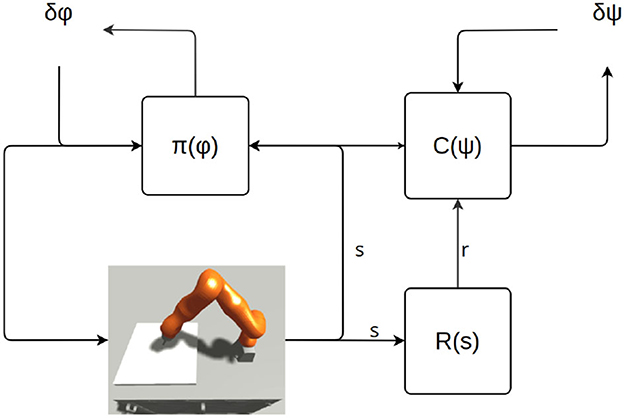
Figure 6. Learning scheme. “R” is the reward function. Π is the policy. Φ represents the parameters of the policy. “C” stands for “critic,” and depending on the actor-critic architecture, it could be a different set of value functions and action-value functions. Ψ represents the parameters of the critic-model(s).
2.4.4. Spiking implementation—PopSAN
Tang et al. (2020) uses SNNs to implement continuous deep RL. Competitive performance is shown through the use of a spiking version of DDPG (Deep Deterministic Policy Gradient). Note that although the actor network is spiking, the critic is non-spiking since its not used for inference and thus does not have to be ported to neuromorphic hardware. PopSAN (Tang et al., 2021) expands upon the results of RateSAN (Tang et al., 2020) with, among others, a spiking version of SAC incorporating population coded input instead of rate coded input networks.5 Our study is based on the PopSAN architecture, which we adapt for the NRP and the robotic insertion task. The networks are architectured as follows. The spiking actor network is a fully connected SNN with LIF neurons and layer sizes 160 × 256 × 256 × 60. The critic networks are fully connected ANNs with ReLU activation functions in the hidden layers and hyperbolic tangent activation functions in the output layer. Both Q-networks have sizes 22 × 256 × 256 × 1. This hybrid training architecture is best implemented on cpu with conventional frameworks. After training, the spiking actor is then ported to the Loihi chip for testing in real neuromorphic hardware for inference, while we do not need the critics anymore.
2.4.5. Domain randomization for robust agents
Domain randomization in the field of robotics is commonly used as a strategy for closing the simulation-to-reality gap (sim2real). It involves multiple training runs, each with randomized parameters to mirror the distribution of the real world domain. In other words, the agent is trained to perform well over a range of situations. Typical dynamic parameters that are commonly randomized include object dimensions and masses, robot link masses and inertia, surface friction coefficients, controller gains, and damping factors (Weng, 2019). Alternatively, disturbances can be added during the training process to reach a similar result. Perturbations could be applied on sensor values, rewards, or even on other parameters that are not generally susceptible to perturbations (i.e., gravity). This can also result in more robust learning.
This study implements parametric domain randomization in the NRP via the Virtual Coach (Section 2.1.4). The training script requires a list or a multidimensional array (defined in numpy) with the experiment IDs. Figure 7 depicts a list of environments in which all dimensions are already sampled from the distributions and collapsed to one dimension. However, it is also possible to use a multidimensional array as an input, where the elements ijk represent the experiment-ID of the environment with the corresponding ijk parameters. For instance, the x, y, z coordinates could represent the friction coefficient μ = i∈X = {0.08, 0.36, 0.80}, end-effector mass m = k∈Z = {κ/2|κ∈[1..5]}, and controller gain kp = j∈Y = {2υ+1|υ∈[0..4]}.
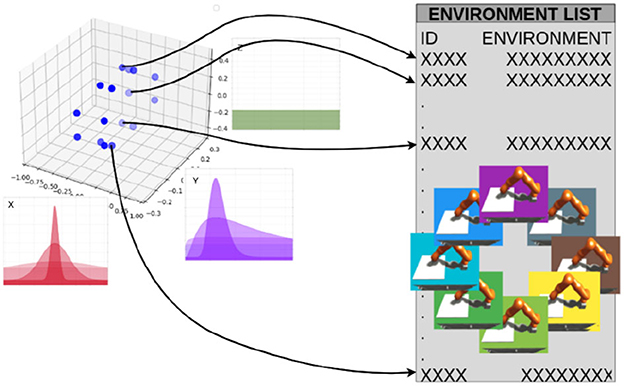
Figure 7. Sampling mechanism: each variable is a parameter that can be randomized. For each dimension of the parameter space, Gaussian and log-Gaussian distributions can be selected as sampling schemes.
In the simplest case, a list with experiment IDs could be used instead of an array. This list or multidimensional array could be generated by hand or via scripts. Given the environment list, the training script selects domains based on four sampling schemes: sequential, uniform, normal, and custom defined. In the case of sequential sampling, the order in the list is used to choose the environments. In the uniform case, all source environments have the same likelihood to be chosen, but there is no imposed order. In the normal case, the sampling parameters are chosen from a Gaussian distribution and then approximated to the closest environment with that parameter as there is no continuum of environments (notice that this will result only in an approximation of strict normal sampling). Finally, additional sampling distributions could be defined and passed as functions to the method.
Furthermore, the definition of the environments could be used to generate more complex sampling distributions: for instance, if the parameters are equidistant in a logarithmic space and a Gaussian sampling strategy is selected, then the sampling scheme would actually be based on a log-normal distribution.
More specifically, to test the approach, we trained single models with extreme friction parameters μ1 = μ2 = 0.08 and μ1 = μ2 = 0.8. A generalized agent trained for the characterized friction parameters μ1, 2 = 0.38 ± 0.4 with domain randomization and we compared the results.
We also implemented a sampling scheme in which wider distributions with more domain variability are progressively selected based on the epoch-number or epoch-performance. This allows the agent to first learn in an easy environment, and once a successful behavior has been reached, the complexity is incremented by progressively extending the variance over the source domain parameter set. One can imagine this as a sort of “training wheels,” which are removed when an agent becomes more adept, inspired from Heim et al. (2018). However, there may be scenarios which benefit from preemptively consideration of the whole range of domain variability. Figure 8 shows an overview of the whole learning approach.
2.4.6. Injecting prior knowledge
As soft actor critic is an off-policy algorithm, the data used for the training can be collected by an arbitrary sampling distribution. We use this fact to bootstrap training with a memory buffer collected by a teacher-agent and relabel it for the new agent. We use a policy trained on a simpler setup with additional hints and information that are not available to the real agent. The teacher agent is able to visit regions of the state space that a random agent at the beginning would not be able to visit.6 Even though the policies differ, pre-training with this data provides at least a notion of the values related to the states. This would be equivalent to transferring the value functions if the state spaces of both agents were to overlap completely.
2.4.7. Consideration of neuromorphic hardware constraints
Once the architecture of the SNN and the synaptic weights have been decided on, implementing the SNN can be easily done in neuromorphic hardware. More specifically, for porting to Loihi 1, we implement the network architecture with NxSDK and load the equivalent synaptic values from the PyTorch models, as done previously in Tang et al. (2021).
One important consideration is the discrepancy in the trained model and the one implemented in hardware. Different hardware alternatives present different resource limitations and discrepancies between their ideal SNN models and simulated versions. For instance, Loihi, being a digital chip, uses neuron states and synaptic weights which accuracy is typically limited to 8 bits, while the LIF model is continuous and its PyTorch simulated version has full precision weights (32 bits).
To deal with this problem, Akl et al. (2021) implements a spiking version of DQN where the weights are kept quantized in the forward pass but treated as real values during the backward pass. This is achieved by using a technique known as the straight-through estimator. Even though this method can only be applied in environments with discrete action spaces and does not consider the neuron state quantization, its results show considerable on-chip performance improvements. Additionally, the concept can be extended to other RL algorithms without major changes.
Additional hardware constraints include the maximum amount of networks per neural core, max amount of neural cores, as well as the max fan-in and max fan-out for core-to-core connections. These values are described in detail in Davies et al. (2018, 2021). Similarly, other alternative neuromorphic chips present different constraints. It is important to consider these to ensure reliable results when porting to hardware. In essence, the process consists in making the model resemble the targeted hardware and consider all its limitations before training or at least approximate the model and assert that the discrepancies do not generate a considerable difference in performance.
3. Results
The materials and methodology presented previously have been used to train robust agents offline and port them to neuromorphic hardware, leading to the following results.
3.1. Spiking neural network—generic training
The training was run for 100 epochs, with 500 episodes and 2000 interactions each. Figure 9 shows the results with training 20 agents with different random seeds in terms of mean return and corresponding standard deviation. We found a 100% insertion success rate across 50 runs using a trained policy. A video of the trained agent can be found in the Supplementary material Video 1.

Figure 9. Learning curves show the results of training with 20 random seeds, the mean performance and the standard deviation.
Figure 9 shows the training profile of 20 different random seeds.
3.2. Inference on neuromorphic hardware
Figure 10 shows measured latency values while running on the Loihi 1 chip. The mean time for an inference step was 1.8 ms for Loihi 1 and 1.5 ms for Loihi 2(for information). As an additional result, the mean energy for inference was measured on the Loihi 2 chip, resulting in a dynamic energy consumption of 53 μJ.
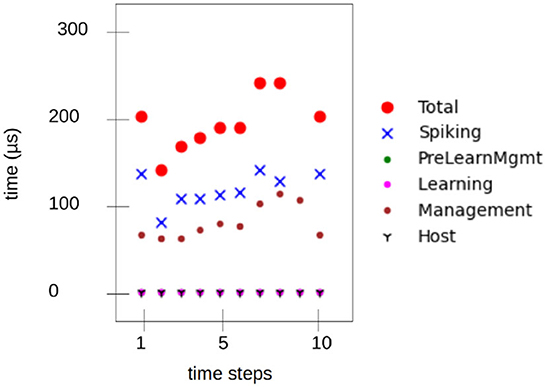
Figure 10. SNN execution time on Loihi 1 measured with state probes over nine steps—equivalent to one inference. The total is 1.8 ms.
3.3. Domain randomization
For domain randomization, the parameters of the friction cone model with μ and μ2 were randomized. D1 denotes a low friction environment with μ = μ2 = 0.2, while D2 denotes a high friction environment with μ = μ2 = 1. DR represents a test environment with a random probability of sampling from the given set of environments. Table 1 shows the cross-evaluation of policies trained specifically for each environment (Π1 & Π2) and the policy trained with randomized environments (ΠR) performing in different domains, where the values portrayed are the mean total sum of rewards of an episode and the performance profile, respectively.
3.4. Learning complex tasks—injecting prior knowledge
When injecting prior knowledge with expert-guided learning, the time needed to reach a policy that consistently inserts the peg can be sped up by a factor of nearly five.
3.5. Consideration of neuromorphic hardware constraints
After training the model from Section 3.1, the performance measure was the insertion success rate. This value did not change after porting the SNN to neuromorphic hardware, and further considerations (such as those presented in Section 2.4.7) were not needed.
4. Discussion
We have presented a framework for training robust neurorobots in domains with variable parameters, as well as for carrying out inference using neuromorphic hardware. This approach uses the NRP, with emphasis on features such as the Virtual Coach and the Integrated Behavioral Architecture. With this approach, a simulated robot was trained to insert a peg into a hole with a small clearance based on only force-torque feedback. The results show 100% insertion success rate after 3 s. We also used domain randomization for addressing problems related to learning in environments with parametric uncertainties. The technique proved to reduce the sim-to-real gap when porting from simulation to a real robot. We document the process of porting these results to a real robot counterpart in a pending separate study.
This study is limited to model-free actor-critic architectures. Other training algorithms might create the need for restructuring the code; however, the main idea of the approach would be the same. Currently, it is not possible to learn during the episode, but this could be solved with use of threads to optimize resources and training time. Similarly, there is currently no support for multiple backends running in parallel, which would be an interesting feature for efficient implementations of distributed learning approaches highly parallelizable algorithms such as PPO (Schulman et al., 2017), or metalearning approaches (Beck et al., 2023). Those features represent some open new avenues for future work.
The results on the generic training show how the algorithm reaches a stable behavior with 100% success rate. The lack of smoothness is due to both the stochasticity of the environment and policy but also to the non-linear reward landscape. Notice how the variance is small at the beginning since all the returns are small and therefore similar for untrained policies. Once the training progresses, some runs would reach high rewards after insertion, while others would not, which generates high variances between runs. Finally, the variance decreases as a 100% insertion rate is reached, and all the returns are similar as there target is always reached. The remaining variance is due to differences in insertion time and other variables.
The results of the inference in neuromorphic hardware and system profiling show that the inference (controlling the robot) can be performed with low latency, low energy consumption, and without meaningful performance loss, namely, accurate inferences below 2ms with a dynamic energy consumption around 50μJ. A more detailed overview about the energy and time profiling for this specific setup is documented in the pending study mentioned above. A real robot counterpart is there controlled with the tools presented here, and more emphasis is set on the hardware.
The results from the domain randomization procedure show a consistent inter-domain overall improvement. The policy trained with domain randomization performs similarly to the policies trained for specific environments in both domains, while the specific policies have a significant performance drop while performing other tasks.
The results when injecting and relabeling prior expert knowledge show significant speed up for reaching a convergent policy in complex environments. The approach does not require a simulator that can be restarted at arbitrary states and resembles other LfD strategies (Argall et al., 2009). However, it requires to have an expert agent, a mapping function, under certain circumstances, this approach is equivalent to transferring knowledge via value functions.
For the sake of the implemented robotic task, quantization-aware training was not needed. One explanation for this might be the fact that we lead the training to learn robust policies, and therefore, the behavior was not sensible to the small changes in weights due to quantization. This could however be an important aspect for other learning environments.
Altogether, the NRP is arguably the most advanced integration platform for connecting robot simulations with in-silico brains currently available, and using adaptations as the one presented in this study expands the horizon of possible implementable setups. In this manuscript, we presented how we extend features such as including neuromorphic hardware platforms (Intel's Loihi Chips), utilizing multi-simulation learning algorithms (SAC), and adding elements as domain randomization to speed up research and move forward the frontiers in neurorobotics.
Data availability statement
The code of the NRP experiment, the training and the inference can be requested to the author's correspondence.
Author contributions
AA and CA contributed to the conception and design of this study. CA conceptualized and implemented the simulation environment, the learning approach, the training porting and inferring on neuromorphic hardware and further processes to obtain and visualize results, and wrote the first draft of the manuscript. AA leads the research group and contributed in conceptualization and management of the project. Both authors contributed to the manuscript, with the revision, proofread, and approval of the submitted version.
Funding
The author(s) declare financial support was received for the research, authorship, and/or publication of this article. This study was funded by the Intel Corporation, in the frame of the Intel Neuromorphic Research Community. The NRP and its contribution to this study was partially funded through the European Union's Horizon 2020 Framework Program for Research and Innovation under the Specific Grant Agreements No. 945539 (Human Brain Project SGA3).
Acknowledgments
The research at fortiss was enabled by the Neurorobotics Platform developed in the frame of the Human Brain Project, European Union's Horizon 2020 Framework Program for Research and Innovation under the Specific Grant Agreements No. 945539 (Human Brain Project SGA3).
Conflict of interest
The authors declare that the research was conducted in the absence of any commercial or financial relationships that could be construed as a potential conflict of interest.
The authors declare that this study received funding from the Intel Corporation. The funder had the following involvement in the study: Intel Corporation provided access and support for using their neuromorphic computing cloud, as well as on neuromorphic hardware device (Loihi 1 in the Kapoho Bay form factor).
Publisher's note
All claims expressed in this article are solely those of the authors and do not necessarily represent those of their affiliated organizations, or those of the publisher, the editors and the reviewers. Any product that may be evaluated in this article, or claim that may be made by its manufacturer, is not guaranteed or endorsed by the publisher.
Supplementary material
The Supplementary Material for this article can be found online at: https://www.frontiersin.org/articles/10.3389/fnbot.2023.1239581/full#supplementary-material
Abbreviations
ANN, Artificial Neural Network; CIC, Cartesian Impedance Controller; CLE, Closed Loop Engine; CUBA-LIF, Current-Based synapse Leaky-Integrate-and-Fire; HBP, Human Brain Project; IBA, Integrated Behavior Architecture; LfD, Learning from Demonstration; LIF, Leaky Integrate and Fire; MDP, Markov Decision Process; NRP, Neurorobotics Platform (v3.x); PopSAN, Population encoded spiking actor network; RateSAN, Rate encoded spiking actor network; RL, Reinforcement Learning; ROS, Robot Operating System; SAC, Soft Actor Critic; SNN, Spiking Neural Network; VC, Virtual Coach.
Footnotes
1. ^We will use the abbreviation NRP to refer to NRP 3. Although the NRP 4 is the latest release, we used exclusively v3 in this work.
2. ^Gazebo is a well-known open source robotic 3D simulator.
3. ^SDK developed by Intel for the Loihi 1 chip.
4. ^The initial pose was located above the insertion pose with some added gaussian noise in all three coordinates. The mean and covariance of the noise distribution were treated as hyper parameters and have a strong influence in learning speed.
5. ^Encoding in the context of a SNN refers to various methods to represent non-event-based information as spiking data. Real numbers can be represented as spiking-rates, spiking-times, or spiking-populations. For full detail refer to Dupeyroux et al. (2021).
6. ^Notice that this is only possible when a function to map the state spaces is available . This mapping could be an approximation, however, no convergence analysis has been done concerning this.
References
Akl, M., Sandamirskaya, Y., Walter, F., and Knoll, A. (2021). “Porting deep spiking q-networks to neuromorphic chip loihi,” in International Conference on Neuromorphic Systems 2021, ICONS 2021. New York, NY, USA: Association for Computing Machinery.
Albu-Schaffer, A., and Hirzinger, G. (2002). “Cartesian impedance control techniques for torque controlled light-weight robots,” in Proceedings 2002 IEEE International Conference on Robotics and Automation (Cat. No.02CH37292). Washington, DC: IEEE.
Albu-Schaffer, A., Ott, C., Frese, U., and Hirzinger, G. (2003). “Cartesian impedance control of redundant robots: recent results with the DLR-light-weight-arms,” in 2003 IEEE International Conference on Robotics and Automation (Cat. No.03CH37422). Taipei: IEEE.
Angelidis, E., Buchholz, E., Arreguit, J., Rougé, A., Stewart, T. C., von Arnim, A., et al. (2021). A spiking central pattern generator for the control of a simulated lamprey robot running on spiNNaker and Loihi neuromorphic boards. Neuromorph. Comput. Eng. 1, 014005. doi: 10.1088/2634-4386/ac1b76
Argall, B. D., Chernova, S., Veloso, M., and Browning, B. (2009). A survey of robot learning from demonstration. Robot. Autonom. Syst. 57, 469–483. doi: 10.1016/j.robot.2008.10.024
Arthur, J. V., and Boahen, K. A. (2011). Silicon-neuron design: a dynamical systems approach. IEEE Antennas Propag. Mag. 58, 1034–1043. doi: 10.1109/TCSI.2010.2089556
Beck, J., Vuorio, R., Liu, E. Z., Xiong, Z., Zintgraf, L., Finn, C., et al. (2023). A survey of meta-reinforcement learning. arXiv preprint arXiv:2301.08028v1. doi: 10.48550/arXiv.2301.08028
Bellec, G., Scherr, F., Subramoney, A., Hajek, E., Salaj, D., Legenstein, R., et al. (2020). A solution to the learning dilemma for recurrent networks of spiking neurons. Nature Commun. 11, 17236. doi: 10.1038/s41467-020-17236-y
Beltran-Hernandez, C. C., Petit, D., Ramirez-Alpizar, I. G., and Harada, K. (2020). Variable compliance control for robotic peg-in-hole assembly: a deep-reinforcement-learning approach. Appl. Sci. 10, 6923. doi: 10.3390/app10196923
Davies, M., Srinivasa, N., Lin, T.-H., Chinya, G., Cao, Y., Choday, S. H., et al. (2018). Loihi: a neuromorphic manycore processor with on-chip learning. IEEE Micro 38, 82–99. doi: 10.1109/MM.2018.112130359
Davies, M., Wild, A., Orchard, G., Sandamirskaya, Y., Guerra, G. A. F., Joshi, P., et al. (2021). Advancing neuromorphic computing with loihi: a survey of results and outlook. Proc. IEEE 109, 911–934. doi: 10.1109/JPROC.2021.3067593
Dupeyroux, J., Stroobants, S., and de Croon, G. (2021). A Toolbox for Neuromorphic Sensing in Robotics.
Falotico, E., Vannucci, L., Ambrosano, A., Albanese, U., Ulbrich, S., Tieck, J. C. V., et al. (2017). Connecting artificial brains to robots in a comprehensive simulation framework: The neurorobotics platform. Front. Neurorobot. 11, 2. doi: 10.3389/fnbot.2017.00002
Haarnoja, T., Zhou, A., Abbeel, P., and Levine, S. (2018). Soft actor-critic: off-policy maximum entropy deep reinforcement learning with a stochastic actor. arXiv preprint arXiv:1801.01290. doi: 10.48550/arXiv.1801.01290
Heim, S., Ruppert, F., Sarvestani, A., and Sproewitz, A. (2018). “Shaping in practice: Training wheels to learn fast hopping directly in hardware,” in Proceedings of the IEEE International Conference on Robotics and Automation (ICRA). Brisbane, QLD: IEEE, 5076–5081.
Hodgkin, A. L., and Huxley, A. F. (1952). A quantitative description of membrane current and its application to conduction and excitation in nerve. J. Physiol. 117, 500–544. doi: 10.1113/jphysiol.1952.sp004764
Hogan, N. (1985). Impedance control: An approach to manipulation: Part i–theory. J. Dyn. Sys. Meas. 107, 1–7. doi: 10.1115/1.3140702
Inoue, T., Magistris, G. D., Munawar, A., Yokoya, T., and Tachibana, R. (2017). Deep reinforcement learning for high precision assembly tasks. arXiv preprint arXiv:1708.04033. doi: 10.48550/arXiv.1708.04033
Kaspar, M., Osorio, J. D. M., and Bock, J. (2020). “Sim2real transfer for reinforcement learning without dynamics randomization,” in 2020 IEEE/RSJ International Conference on Intelligent Robots and Systems (IROS) (Las Vegas, NV: IEEE; RSJ).
Lillicrap, T. P., Santoro, A., Marris, L., Akerman, C. J., and Hinton, G. (2020). Backpropagation and the brain. Nat. Rev. Neurosci. 21, 335–346. doi: 10.1038/s41583-020-0277-3
Schulman, J., Wolski, F., Dhariwal, P., Radford, A., and Klimov, O. (2017). Proximal policy optimization algorithms. arXiv preprint arXiv:1707.06347. doi: 10.48550/arXiv.1707.06347
Tang, G., Kumar, N., and Michmizos, K. P. (2020). “Reinforcement co-learning of deep and spiking neural networks for energy-efficient mapless navigation with neuromorphic hardware,” in 2020 IEEE/RSJ International Conference on Intelligent Robots and Systems (IROS) (Las Vegas, NV: IEEE).
Tang, G., Kumar, N., Yoo, R., and Michmizos, K. (2021). “Deep reinforcement learning with population-coded spiking neural network for continuous control,” in Proceedings of the 2020 Conference on Robot Learning, eds. J. Kober, F. Ramos, and C. Tomlin. London: PMLR, 2016–2029.
Weng, L. (2019). Domain Randomization for Sim2Real Transfer. Available online at: https://lilianweng.github.io/posts/2019-05-05-domain-randomization/ (accessed August, 2022).
Xu, J., Hou, Z., Liu, Z., and Qiao, H. (2019). Compare contact model-based control and contact model-free learning: a survey of robotic peg-in-hole assembly strategies. arXiv preprint arXiv:1904.05240. doi: 10.48550/arXiv.1904.05240
Yang, S., and Chen, B. (2023). Snib: Improving spike-based machine learning using nonlinear information bottleneck. IEEE Transa. Syst. Man Cybern. 318, 1–12. doi: 10.1109/TSMC.2023.3300318
Yang, S., Pang, Y., Wang, H., Lei, T., Pan, J., Wang, J., et al. (2023). Spike-driven multi-scale learning with hybrid mechanisms of spiking dendrites. Neurocomputing 542, 126240. doi: 10.1016/j.neucom.2023.126240
Keywords: domain randomization, neuromorphic computing, neurorobotics, reinforcement learning, robot control, spiking neural networks
Citation: Amaya C and von Arnim A (2023) Neurorobotic reinforcement learning for domains with parametrical uncertainty. Front. Neurorobot. 17:1239581. doi: 10.3389/fnbot.2023.1239581
Received: 13 June 2023; Accepted: 26 September 2023;
Published: 25 October 2023.
Edited by:
Zhang Hengmin, Nanyang Technological University, SingaporeReviewed by:
Garibaldi Pineda García, Applied AGI, United KingdomShuangming Yang, Tianjin University, China
Copyright © 2023 Amaya and von Arnim. This is an open-access article distributed under the terms of the Creative Commons Attribution License (CC BY). The use, distribution or reproduction in other forums is permitted, provided the original author(s) and the copyright owner(s) are credited and that the original publication in this journal is cited, in accordance with accepted academic practice. No use, distribution or reproduction is permitted which does not comply with these terms.
*Correspondence: Axel von Arnim, dm9uYXJuaW1AZm9ydGlzcy5vcmc=
 Camilo Amaya
Camilo Amaya Axel von Arnim
Axel von Arnim